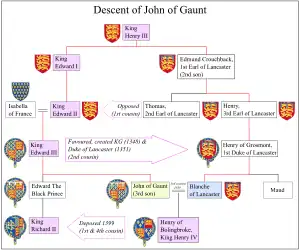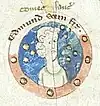Earl of Lancaster
The title of Earl of Lancaster was created in the Peerage of England in 1267. It was succeeded by the title Duke of Lancaster in 1351, which expired in 1361. (The most recent creation of the ducal title merged with the Crown in 1413.)
| Earldom of Lancaster | |
|---|---|
  Arms of Edmund Crouchback, 1st Earl of Lancaster, 1st Earl of Leicester: Royal arms of King Henry III with a label of three points of France for difference | |
| Creation date | 30 June 1267 |
| Created by | Henry III of England |
| Peerage | Peerage of England |
| First holder | Edmund Crouchback |
| Last holder | Henry of Grosmont |
| Subsidiary titles | Earl of Leicester |
| Extinction date | 23 March 1361 |
| Seat(s) | Lancaster Castle |
King Henry III of England created the Earldom of Lancaster—from which the royal house of Henry IV was named—for his second son, Edmund Crouchback, in 1267. Edmund had already been created Earl of Leicester in 1265 and following the Second Barons' War and the death and attainder of the king's rebellious brother-in-law Simon de Montfort, 6th Earl of Leicester[1] in 1265, the latter's lands, including most notably Kenilworth Castle in Warwickshire, had been awarded to him.
When Edmund's son Thomas, 2nd Earl of Lancaster, inherited the estates and title of his father-in-law Henry de Lacy, 3rd Earl of Lincoln, he became at a stroke the most powerful nobleman in England, with lands throughout the kingdom and the ability to raise vast private armies to wield power at national and local levels.[2] This brought him—and his younger brother Henry, 3rd Earl of Lancaster—into conflict with their first cousin King Edward II, leading to Thomas's execution. Henry inherited Thomas's titles and he and his son Henry of Grosmont, 1st Duke of Lancaster, gave loyal service to Edward's son— King Edward III.
History

Creation
After the supporters of Henry III of England suppressed opposition from the English nobility in the Second Barons' War, Henry granted to his second son Edmund Crouchback the titles and possessions forfeited by attainder of the barons' leader, Simon de Montfort, 6th Earl of Leicester, including the Earldom of Leicester, on 26 October 1265. Later grants included the first Earldom of Lancaster on 30 June 1267 and that of Earl Ferrers in 1301. Edmund was also Count of Champagne and Brie from 1276 by right of his wife.[1] Henry IV of England would later use his descent from Edmund to legitimise his claim to the throne, even making the spurious claim that Edmund was the elder son of Henry but had been passed over as king because of his deformity.[3]

Edmund's second marriage to Blanche of Artois, the widow of the King of Navarre, placed him at the centre of the European aristocracy. Blanche's daughter Joan I of Navarre was queen regnant of Navarre and through her marriage to Philip IV of France was queen consort of France. Edmund's son Thomas became the most powerful nobleman in England, gaining the Earldoms of Lincoln and Salisbury through marriage to the heiress of Henry de Lacy, 3rd Earl of Lincoln. His income was £11,000 per annum—double that of the next wealthiest earl.[2]
Thomas and his younger brother Henry served in the coronation of their cousin King Edward II of England on 25 February 1308; Thomas carried Curtana, the Sword of Mercy, and Henry carried the royal sceptre.[4] After initially supporting Edward, Thomas became one of the Lords Ordainers, who demanded the banishment of Piers Gaveston and the governance of the realm by a baronial council. After Gaveston was captured, Thomas took the lead in his trial and execution at Warwick in 1312.[5] Edward's authority was weakened by poor governance and defeat by the Scots at the Battle of Bannockburn. This allowed Thomas to restrain Edward's power by republishing the Ordinances of 1311. Following this achievement Thomas took little part in the governance of the realm and instead retreated to Pontefract Castle.[6] This allowed Edward to regroup and re-arm, leading to a fragile peace in August 1318 with the Treaty of Leake. In 1321 Edward's rule again collapsed into civil war. Thomas raised a northern army but was defeated and captured at the Battle of Boroughbridge. He was sentenced to be hanged, drawn and quartered but because he was Edward's cousin he was given a quicker death by beheading.[7]
Henry joined the revolt of Edward's wife Isabella of France and her lover Mortimer in 1326, pursuing and capturing Edward at Neath in South Wales.[7] Following Edward's deposition at the Parliament of Kenilworth in 1326 and reputed murder at Berkeley Castle,[8] Thomas's conviction was posthumously reversed and Henry regained possession of the Earldoms of Lancaster, Derby, Salisbury and Lincoln that had been forfeit for Thomas's treason. His restored prestige led to him knighting the young King Edward III of England before his coronation.[9] Mortimer lost support over the Treaty of Edinburgh–Northampton that formalised Scotland's independence, and his developing power in the Welsh Marches provoked jealousy from the barons. When Mortimer called a parliament to make his new powers and estates permanent with the title of Earl of March in 1328, Henry led the opposition and held a counter-meeting. In response, Mortimer ravaged the lands of Lancaster and checked the revolt. Edward III was able to assume control in 1330 but Henry's further influence was restricted by poor health and blindness for the last fifteen years of his life.[10][11]
Succession
Henry's son, also called Henry, was born at the castle of Grosmont in Monmouthshire between 1299 and 1314.[12] According to the younger Henry's memoirs, he was better at martial arts than academic subjects and did not learn to read until later in life.[13] Henry was coeval with Edward III and was pivotal to his reign, becoming his best friend and most trusted commander.[14] Henry was knighted in 1330, represented his father in parliament and fought in Edward's Scottish campaign.[15] After the outbreak of the Hundred Years' War, Henry took part in several diplomatic missions and minor campaigns and was present at the great English victory in the naval Battle of Sluys in 1340.[16] Later, he was required to commit himself as hostage in the Low Countries for Edward's considerable debts. He remained hostage for a year and had to pay a large ransom for his own release.[17]
In 1345, Edward III launched a major, three-pronged attack on France. The Earl of Northampton attacked from Brittany, Edward from Flanders, and Henry from Aquitaine in the south.[14] Moving rapidly through the country, Henry confronted the Comte d'Isle at the Battle of Auberoche and achieved a victory described as "the greatest single achievement of Lancaster's entire military career".[18] The ransom from the prisoners has been estimated at £50,000.[19] Edward rewarded Henry by including him as a founding knight of the Order of the Garter.[20] An even greater honour was bestowed on Lancaster when Edward created him Duke of Lancaster. The title of duke was relatively new in England, with only Cornwall being a previous ducal title. Lancaster was also given palatinate status for the county of Lancashire, which entailed a separate administration independent of the crown.[21] There were two other counties palatine; Durham was an ancient ecclesiastical palatinate and Chester was crown property.
Earls of Lancaster
Family tree
| Family tree of the Dukes of: Beaufort, Lancaster, and Somerset, Marquesses of: Dorset, Hertford, Somerset and Worcester, and Earls of: Dorset, Hertford, Lancaster, Leicester, Somerset, and Worcester | |||||||||||||||||||||||||||||||||||||||||||||||||||||||||||||||||||||||||||||||||||||||||||||||||||||||||||||||||||||||||||||||||||||||||||||||||||||||||||||||||||||||||||||||||||||||||||||||||||||||||||||||||||||||||||||||||||||||||||||||||||||||||||||||||||||||||||||||||||||||||||||||||||||||||||||||||||||||||||||||||||||||||||||||||||||||||||||||||||||||||||||||||||||||||||||||||||||||||||||||||||||||||||||||||||||||||||||||||||||||||||||||||||||||||||||||||||||||||||||||||||||||||||||||||||||||||||||||||||||||||||||||||||||||||||||||||||||||||||||||||||||||||||||||||||||||||||||||||||||||||||||||||||||||||||||||||||||||||||||||||||||||||||||||||||||||||||||||||||||||||||||||||||||||||||||||||||||||||||||||||||||||||||||||||||||||||||||||||||||||||||||||||||||||||||||||||||||||||||||||||||||||||||||||||||||||||||||||||||||||||||||||||||||||||||||||||||||||||||||||||||||||||||||||||||||||||||||||||||||||||||||||||||||||||||||||||||||||||||||||||||||||||||||||||||||||||||||||||||||||
|---|---|---|---|---|---|---|---|---|---|---|---|---|---|---|---|---|---|---|---|---|---|---|---|---|---|---|---|---|---|---|---|---|---|---|---|---|---|---|---|---|---|---|---|---|---|---|---|---|---|---|---|---|---|---|---|---|---|---|---|---|---|---|---|---|---|---|---|---|---|---|---|---|---|---|---|---|---|---|---|---|---|---|---|---|---|---|---|---|---|---|---|---|---|---|---|---|---|---|---|---|---|---|---|---|---|---|---|---|---|---|---|---|---|---|---|---|---|---|---|---|---|---|---|---|---|---|---|---|---|---|---|---|---|---|---|---|---|---|---|---|---|---|---|---|---|---|---|---|---|---|---|---|---|---|---|---|---|---|---|---|---|---|---|---|---|---|---|---|---|---|---|---|---|---|---|---|---|---|---|---|---|---|---|---|---|---|---|---|---|---|---|---|---|---|---|---|---|---|---|---|---|---|---|---|---|---|---|---|---|---|---|---|---|---|---|---|---|---|---|---|---|---|---|---|---|---|---|---|---|---|---|---|---|---|---|---|---|---|---|---|---|---|---|---|---|---|---|---|---|---|---|---|---|---|---|---|---|---|---|---|---|---|---|---|---|---|---|---|---|---|---|---|---|---|---|---|---|---|---|---|---|---|---|---|---|---|---|---|---|---|---|---|---|---|---|---|---|---|---|---|---|---|---|---|---|---|---|---|---|---|---|---|---|---|---|---|---|---|---|---|---|---|---|---|---|---|---|---|---|---|---|---|---|---|---|---|---|---|---|---|---|---|---|---|---|---|---|---|---|---|---|---|---|---|---|---|---|---|---|---|---|---|---|---|---|---|---|---|---|---|---|---|---|---|---|---|---|---|---|---|---|---|---|---|---|---|---|---|---|---|---|---|---|---|---|---|---|---|---|---|---|---|---|---|---|---|---|---|---|---|---|---|---|---|---|---|---|---|---|---|---|---|---|---|---|---|---|---|---|---|---|---|---|---|---|---|---|---|---|---|---|---|---|---|---|---|---|---|---|---|---|---|---|---|---|---|---|---|---|---|---|---|---|---|---|---|---|---|---|---|---|---|---|---|---|---|---|---|---|---|---|---|---|---|---|---|---|---|---|---|---|---|---|---|---|---|---|---|---|---|---|---|---|---|---|---|---|---|---|---|---|---|---|---|---|---|---|---|---|---|---|---|---|---|---|---|---|---|---|---|---|---|---|---|---|---|---|---|---|---|---|---|---|---|---|---|---|---|---|---|---|---|---|---|---|---|---|---|---|---|---|---|---|---|---|---|---|---|---|---|---|---|---|---|---|---|---|---|---|---|---|---|---|---|---|---|---|---|---|---|---|---|---|---|---|---|---|---|---|---|---|---|---|---|---|---|---|---|---|---|---|---|---|---|---|---|---|---|---|---|---|---|---|---|---|---|---|---|---|---|---|---|---|---|---|---|---|---|---|---|---|---|---|---|---|---|---|---|---|---|---|---|---|---|---|---|---|---|---|---|---|---|---|---|---|---|---|---|---|---|---|---|---|---|---|---|---|---|---|---|---|---|---|---|---|---|---|---|---|---|---|---|---|---|---|---|---|---|---|---|---|---|---|---|---|---|---|---|---|---|---|---|---|---|---|---|---|---|---|---|---|---|---|---|---|---|---|---|---|---|---|---|---|---|---|---|---|---|---|---|---|---|---|---|---|---|---|---|---|---|---|---|---|---|---|---|---|---|---|---|---|---|---|---|---|---|---|---|---|---|---|---|---|---|---|---|---|---|---|---|---|---|---|---|---|---|---|---|---|---|---|---|---|---|---|---|---|---|---|---|---|---|---|---|---|---|---|---|---|---|---|---|---|---|---|---|---|---|---|---|---|---|---|---|---|---|---|---|---|---|---|---|---|---|---|---|---|---|---|---|---|---|---|---|---|---|---|---|---|---|---|---|---|---|---|---|---|---|---|---|---|---|---|---|---|---|---|---|---|---|---|---|---|---|---|---|---|---|---|---|---|---|---|---|---|---|---|---|---|---|---|---|---|---|---|---|---|---|---|---|---|---|---|---|---|---|---|---|---|---|---|---|---|---|---|---|---|---|---|---|---|---|---|---|---|---|---|---|---|---|---|---|---|---|---|---|---|---|---|---|---|---|---|---|---|---|---|---|---|---|---|---|---|---|---|---|---|---|---|---|---|---|---|---|---|---|---|---|---|---|---|---|---|---|---|---|---|---|---|---|---|---|---|---|---|---|---|---|---|---|---|---|---|---|---|---|---|---|---|
| |||||||||||||||||||||||||||||||||||||||||||||||||||||||||||||||||||||||||||||||||||||||||||||||||||||||||||||||||||||||||||||||||||||||||||||||||||||||||||||||||||||||||||||||||||||||||||||||||||||||||||||||||||||||||||||||||||||||||||||||||||||||||||||||||||||||||||||||||||||||||||||||||||||||||||||||||||||||||||||||||||||||||||||||||||||||||||||||||||||||||||||||||||||||||||||||||||||||||||||||||||||||||||||||||||||||||||||||||||||||||||||||||||||||||||||||||||||||||||||||||||||||||||||||||||||||||||||||||||||||||||||||||||||||||||||||||||||||||||||||||||||||||||||||||||||||||||||||||||||||||||||||||||||||||||||||||||||||||||||||||||||||||||||||||||||||||||||||||||||||||||||||||||||||||||||||||||||||||||||||||||||||||||||||||||||||||||||||||||||||||||||||||||||||||||||||||||||||||||||||||||||||||||||||||||||||||||||||||||||||||||||||||||||||||||||||||||||||||||||||||||||||||||||||||||||||||||||||||||||||||||||||||||||||||||||||||||||||||||||||||||||||||||||||||||||||||||||||||||||||
See also
Notes
- Both Henry of Grosmont and John of Gaunt are listed as the 1st Duke of Lancaster. This is because the Dukedom could only be passed down to a son; when Henry of Grosmont died on 23 March 1361, the Earldom passed to his son-in-law John of Gaunt but the Dukedom expired. A new Dukedom with the identical name was created for John of Gaunt on 13 November 1362 by his Father, Edward III.
References
- Weir 2008, p. 75
- Jones 2012, pp. 371
- Weir 1995, p. 40
- Jones 2012, pp. 363
- Jones 2012, pp. 375–8
- Jones 2012, p. 390
- Jones 2012, p. 400
- Davies 1999, p. 381
- Jones 2012, p. 422
- Waugh & Harrison 2004
- Lee 1997, p. 115
- Weir 2008, p. 77
- Fowler 1969, p. 26
- Jones 2012, p. 471
- Fowler 1969, p. 30
- Fowler 1969, p. 34
- Fowler 1969, pp. 35–7
- Fowler 1969, pp. 58–9
- Fowler 1969, p. 61
- McKisack 1959, pp. 252
- Fowler 1969, pp. 173–4
- Lloyd & Harrison 2004
- Weir 2008, pp. 76–7
- Walker 1990
Sources
- Castor, Helen (2000). The King, the Crown, and the Duchy of Lancaster: Public Authority and Private Power, 1399-1461. Oxford: Oxford University Press. pp. 8–21. ISBN 0-19-820622-4.
- Davies, Norman (1999). The Isles : a history. Oxford: Oxford University Press. ISBN 0-19-513442-7. OCLC 41156575.
- Fowler, Kenneth Alan (1969). The King's Lieutenant: Henry of Grosmont, First Duke of Lancaster, 1310-1361. London. ISBN 0-236-30812-2.
{{cite book}}: CS1 maint: location missing publisher (link) - Given-Wilson, C. (June 1994). "Richard II, Edward II, and the Lancastrian Inheritance". The English Historical Review. 109 (432): 553–571. doi:10.1093/ehr/CIX.432.553.
- Goodman, Anthony (1992). John of Gaunt: The Exercise of Princely Power in Fourteenth-Century Europe. Burnt Mill, Harlow, Essex: Longman. ISBN 0-582-09813-0.
- Jones, Dan (2012). The Plantagenets: The Kings Who Made England. HarperPress. ISBN 978-0-00-745749-6.
- Lee, Christopher (1997). This Sceptred Isle. Penguin Books. ISBN 978-1-84529-994-1.
- Lloyd, Simon; Harrison, B. (2004). "Edmund, first earl of Lancaster and first earl of Leicester (1245–1296)". Oxford Dictionary of National Biography. Oxford Dictionary of National Biography (online ed.). Oxford: Oxford University Press. doi:10.1093/ref:odnb/8504. (Subscription or UK public library membership required.)
- McKisack, May (1959). The Fourteenth Century: 1307–1399. Oxford: Oxford University Press. ISBN 0-19-821712-9.
- Maddicott, J. R. (1970). Thomas of Lancaster, 1307–1322: A study in the reign of Edward II. Oxford: Oxford University Press. ISBN 0-19-821837-0.
- Mortimer, Ian (2007). The Fears of King Henry IV: The Life of England's Self-Made King. London: Jonathan Cape. ISBN 978-0-224-07300-4.
- Powicke, F. M. (1947). King Henry III and the Lord Edward: The Community of the Realm in the Thirteenth Century. Oxford: Clarendon Press. ISBN 0-19-821837-0.
- Powicke, F. M. (1953). The Thirteenth Century: 1216-1307. Oxford: Clarendon Press. ISBN 0-19-285249-3.
- Powicke, F. M.; Fryde, E.B. (1961). Handbook of British Chronology (2nd ed.). London: Royal Historical Society. pp. 434–5.
- Prestwich, Michael (2007). Plantagenet England 1225–1360. Oxford: Oxford University Press. ISBN 978-0-19-922687-0.
- Somerville, Robert (1953). History of the Duchy of Lancaster. Vol. 1. London: Chancellor and Council of the Duchy of Lancaster.
- Walker, Simon (1990). The Lancastrian Affinity 1361-1399. Oxford: Clarendon Press. ISBN 0-19-820174-5.
- Waugh, Scott L.; Harrison, B. (2004). "'Henry of Lancaster, third earl of Lancaster and third earl of Leicester (c.1280–1345)". Oxford Dictionary of National Biography. Oxford Dictionary of National Biography (online ed.). Oxford: Oxford University Press. doi:10.1093/ref:odnb/12959. (Subscription or UK public library membership required.)
- Weir, Alison (1995). Lancaster and York : the Wars of the Roses. London: Jonathan Cape. ISBN 0-224-03834-6. OCLC 32700817.
- Weir, Alison (2008). Britain's Royal Families: The Complete Genealogy. London: Vintage Books. ISBN 9780099539735.



%252C_f.8_-_BL_Stowe_MS_594_(cropped).jpg.webp)
